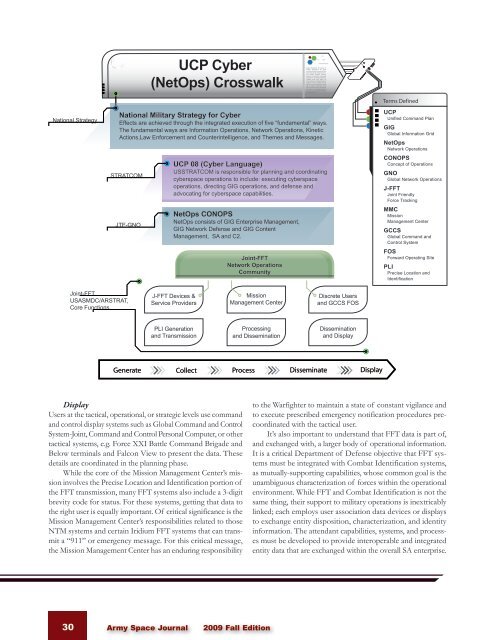Volume 8, Number 3 - Space and Missile Defense Command - U.S. ...
Volume 8, Number 3 - Space and Missile Defense Command - U.S. ...
Volume 8, Number 3 - Space and Missile Defense Command - U.S. ...
Create successful ePaper yourself
Turn your PDF publications into a flip-book with our unique Google optimized e-Paper software.
UCP Cyber<br />
(NetOps) Crosswalk<br />
National Strategy<br />
National Military Strategy for Cyber<br />
Effects are achieved through the integrated execution of five “fundamental” ways.<br />
The fundamental ways are Information Operations, Network Operations, Kinetic<br />
Actions,Law Enforcement <strong>and</strong> Counterintelligence, <strong>and</strong> Themes <strong>and</strong> Messages.<br />
STRATCOM<br />
JTF-GNO<br />
UCP 08 (Cyber Language)<br />
USSTRATCOM is responsible for planning <strong>and</strong> coordinating<br />
cyberspace operations to include: executing cyberspace<br />
operations, directing GIG operations, <strong>and</strong> defense <strong>and</strong><br />
advocating for cyberspace capabilities.<br />
NetOps CONOPS<br />
NetOps consists of GIG Enterprise Management,<br />
GIG Network <strong>Defense</strong> <strong>and</strong> GIG Content<br />
Management, SA <strong>and</strong> C2.<br />
Joint-FFT<br />
Network Operations<br />
Community<br />
Terms Defined<br />
UCP<br />
Unified Comm<strong>and</strong> Plan<br />
GIG<br />
Global Information Grid<br />
NetOps<br />
Network Operations<br />
CONOPS<br />
Concept of Operations<br />
GNO<br />
Global Network Operations<br />
J-FFT<br />
Joint Friendly<br />
Force Tracking<br />
MMC<br />
Mission<br />
Management Center<br />
GCCS<br />
Global Comm<strong>and</strong> <strong>and</strong><br />
Control System<br />
FOS<br />
Forward Operating Site<br />
PLI<br />
Precise Location <strong>and</strong><br />
Identification<br />
Joint-FFT<br />
USASMDC/ARSTRAT,<br />
Core Functions<br />
J-FFT Devices &<br />
Service Providers<br />
Mission<br />
Management Center<br />
Discrete Users<br />
<strong>and</strong> GCCS FOS<br />
PLI Generation<br />
<strong>and</strong> Transmission<br />
Processing<br />
<strong>and</strong> Dissemination<br />
Dissemination<br />
<strong>and</strong> Display<br />
Display<br />
Users at the tactical, operational, or strategic levels use comm<strong>and</strong><br />
<strong>and</strong> control display systems such as Global Comm<strong>and</strong> <strong>and</strong> Control<br />
System-Joint, Comm<strong>and</strong> <strong>and</strong> Control Personal Computer, or other<br />
tactical systems, e.g. Force XXI Battle Comm<strong>and</strong> Brigade <strong>and</strong><br />
Below terminals <strong>and</strong> Falcon View to present the data. These<br />
details are coordinated in the planning phase.<br />
While the core of the Mission Management Center’s mission<br />
involves the Precise Location <strong>and</strong> Identification portion of<br />
the FFT transmission, many FFT systems also include a 3-digit<br />
brevity code for status. For these systems, getting that data to<br />
the right user is equally important. Of critical significance is the<br />
Mission Management Center’s responsibilities related to those<br />
NTM systems <strong>and</strong> certain Iridium FFT systems that can transmit<br />
a “911” or emergency message. For this critical message,<br />
the Mission Management Center has an enduring responsibility<br />
to the Warfighter to maintain a state of constant vigilance <strong>and</strong><br />
to execute prescribed emergency notification procedures precoordinated<br />
with the tactical user.<br />
It’s also important to underst<strong>and</strong> that FFT data is part of,<br />
<strong>and</strong> exchanged with, a larger body of operational information.<br />
It is a critical Department of <strong>Defense</strong> objective that FFT systems<br />
must be integrated with Combat Identification systems,<br />
as mutually-supporting capabilities, whose common goal is the<br />
unambiguous characterization of forces within the operational<br />
environment. While FFT <strong>and</strong> Combat Identification is not the<br />
same thing, their support to military operations is inextricably<br />
linked; each employs user association data devices or displays<br />
to exchange entity disposition, characterization, <strong>and</strong> identity<br />
information. The attendant capabilities, systems, <strong>and</strong> processes<br />
must be developed to provide interoperable <strong>and</strong> integrated<br />
entity data that are exchanged within the overall SA enterprise.<br />
30<br />
Army <strong>Space</strong> Journal<br />
2009 Fall Edition
















